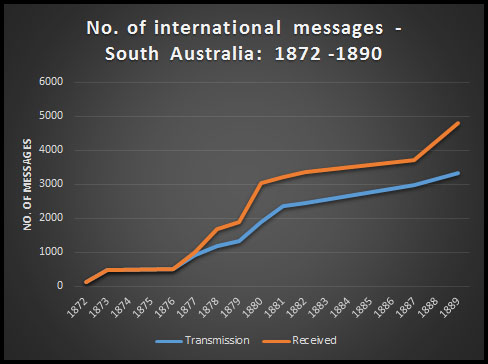Overview of S. A. developments.
- Australia 1901-1988
- New South Wales
- Queensland
- South Australia
- Tasmania
- Victoria
- Western Australia
- International
- Special aspects
Summaries are provided below for:
- construction of the major telegraph line initiatives;
- milestones in the Legislation for and the administration of the Telegraph Department in South Australia;
- the dates for new developments in telegraph forms and date stamps;
- extent of use of the telegraph lines;
- Summary of Annual Reports and other Reports contained in this site.
| 26 November 1855 | James Wallace McGeorge opened a private telegraph line between Adelaide and Port Adelaide. |
| January 1856 | S.A. Government bought McGeorge’s telegraph line. |
| 18 February 1856 | S.A. Government opened its first line from Adelaide to Port Adelaide. |
| 22 May 1858 | First line to Victoria (via Mount Gambia and Portland) operational. |
| 11 September 1866. | First line to New South Wales (via Overland Corner and Wentworth) operational. |
| 8 December 1877. | First line to Western Australia (via Eucla) operational. |
See the overview of line construction in South Australia and the listing of Telegraph Offices in South Australia.
| 4 November 1855 | Charles Todd with his wife Alice arrive to take up his position of Superintendent of Telegraphs and Government Astronomer. He is accompanied by Mr. E. C. Cracknell (his first assistant) and significant supplies of telegraph equipment. |
| 1857 | Act No. 6 providing for the construction and management of Electric Telegraphs - "An Act to regulate the construction and mmanagement of Electric Telegraph 1857". |
| March 1858 | Royal Assent to the Electric Telegraphs Act. |
| 1869 | Electric Telegraph Department merged with the Postmaster-General's Department but retained the Electric Telegraph Department heading on stationery. |
| 1870 | Todd appointed to the dual position of Postmaster-General and Superintendent of Telegraphs following the decision to amalgamate the two Departments. |
| 1890 | "The telegraph operators are seriously contemplating the formation of a Union, with a view to remedying a number of grievances. The main cause of discontent is seated to be that men who have been in the service for eight and nine years' are only receiving from £60 to .£80 per annum" (Daily News (Perth) 11 February 1890). |
See the list of Official Reports for South Australia included in this website.
| Earliest recorded forms: | |
| Transmission form: | 19 February 1894 at Morgan (SC-TO-3). |
| Delivery form: | 17 November 1857 (SC-DO-1). |
| On the Overland Telegraph Line: | 4 November 1876 (SC-DO-4A). |
| Earliest use of a date stamp on a telegram form: | 4 November 1876 at Glenelg (SC-DO-5A). |
| Earliest use of a Telegraph date stamp: | 16 May 1888 at Telegraph Office, SA. |
Domestic
"The estimated revenue for the year 1857, as based on the receipts for the first six months, is £1,200 and if to this is added £500 as the value of Government messages, the monetary value of the telegraph would be £1,700. The working expenses being £1,232, there would remain a nominal profit of £468 to represent the interest on the capital of £4,600. Even if the Government messages are left out of the calculation, the receipts are sufficient to cover the expenses. Considering the limited amount of the population, this result is not discouraging; andlittle country townships can yield enough business to make the telegraph pay expenses, a line connecting the three chief cities with the principal intermediate townships will probably yield a fair profit" (Sydney Morning Herald 23 December 1857).
An Extract from the 1892 Intercolonial Postal and Telegraphic Conference held in Hobart during March 1892 included the followng summary for South Australia on page 86:
International.
 |
